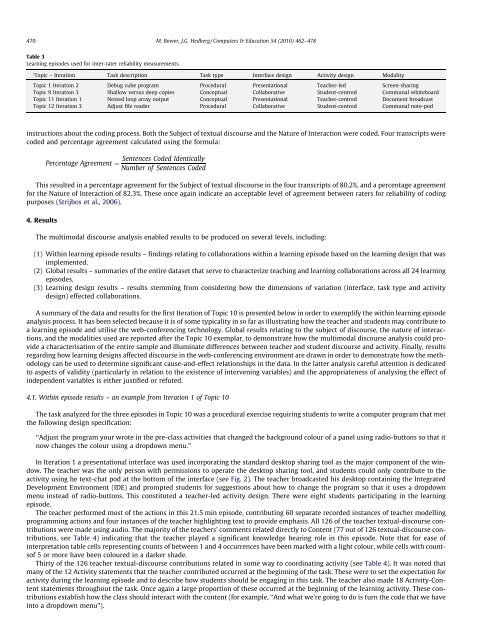A quantitative multimodal discourse analysis of ... - Anitacrawley.net
A quantitative multimodal discourse analysis of ... - Anitacrawley.net
A quantitative multimodal discourse analysis of ... - Anitacrawley.net
You also want an ePaper? Increase the reach of your titles
YUMPU automatically turns print PDFs into web optimized ePapers that Google loves.
470 M. Bower, J.G. Hedberg / Computers & Education 54 (2010) 462–478Table 3Learning episodes used for inter-rater reliability measurements.‘Topic – Iteration Task description Task type Interface design Activity design ModalityTopic 1 Iteration 2 Debug cube program Procedural Presentational Teacher-led Screen-sharingTopic 9 Iteration 3 Shallow versus deep copies Conceptual Collaborative Student-centred Communal whiteboardTopic 11 Iteration 1 Nested loop array output Conceptual Presentational Teacher-centred Document broadcastTopic 12 Iteration 3 Adjust file reader Procedural Collaborative Student-centred Communal note-podinstructions about the coding process. Both the Subject <strong>of</strong> textual <strong>discourse</strong> and the Nature <strong>of</strong> Interaction were coded. Four transcripts werecoded and percentage agreement calculated using the formula:Sentences Coded IdenticallyPercentage Agreement ¼Number <strong>of</strong> Sentences CodedThis resulted in a percentage agreement for the Subject <strong>of</strong> textual <strong>discourse</strong> in the four transcripts <strong>of</strong> 80.2%, and a percentage agreementfor the Nature <strong>of</strong> Interaction <strong>of</strong> 82.3%. These once again indicate an acceptable level <strong>of</strong> agreement between raters for reliability <strong>of</strong> codingpurposes (Strijbos et al., 2006).4. ResultsThe <strong>multimodal</strong> <strong>discourse</strong> <strong>analysis</strong> enabled results to be produced on several levels, including:(1) Within learning episode results – findings relating to collaborations within a learning episode based on the learning design that wasimplemented.(2) Global results – summaries <strong>of</strong> the entire dataset that serve to characterize teaching and learning collaborations across all 24 learningepisodes.(3) Learning design results – results stemming from considering how the dimensions <strong>of</strong> variation (interface, task type and activitydesign) effected collaborations.A summary <strong>of</strong> the data and results for the first Iteration <strong>of</strong> Topic 10 is presented below in order to exemplify the within learning episode<strong>analysis</strong> process. It has been selected because it is <strong>of</strong> some typicality in so far as illustrating how the teacher and students may contribute toa learning episode and utilise the web-conferencing technology. Global results relating to the subject <strong>of</strong> <strong>discourse</strong>, the nature <strong>of</strong> interactions,and the modalities used are reported after the Topic 10 exemplar, to demonstrate how the <strong>multimodal</strong> <strong>discourse</strong> <strong>analysis</strong> could providea characterisation <strong>of</strong> the entire sample and illuminate differences between teacher and student <strong>discourse</strong> and activity. Finally, resultsregarding how learning designs affected <strong>discourse</strong> in the web-conferencing environment are drawn in order to demonstrate how the methodologycan be used to determine significant cause-and-effect relationships in the data. In the latter <strong>analysis</strong> careful attention is dedicatedto aspects <strong>of</strong> validity (particularly in relation to the existence <strong>of</strong> intervening variables) and the appropriateness <strong>of</strong> analysing the effect <strong>of</strong>independent variables is either justified or refuted.4.1. Within episode results – an example from Iteration 1 <strong>of</strong> Topic 10The task analyzed for the three episodes in Topic 10 was a procedural exercise requiring students to write a computer program that metthe following design specification:‘‘Adjust the program your wrote in the pre-class activities that changed the background colour <strong>of</strong> a panel using radio-buttons so that itnow changes the colour using a dropdown menu.”In Iteration 1 a presentational interface was used incorporating the standard desktop sharing tool as the major component <strong>of</strong> the window.The teacher was the only person with permissions to operate the desktop sharing tool, and students could only contribute to theactivity using he text-chat pod at the bottom <strong>of</strong> the interface (see Fig. 2). The teacher broadcasted his desktop containing the IntegratedDevelopment Environment (IDE) and prompted students for suggestions about how to change the program so that it uses a dropdownmenu instead <strong>of</strong> radio-buttons. This constituted a teacher-led activity design. There were eight students participating in the learningepisode.The teacher performed most <strong>of</strong> the actions in this 21.5 min episode, contributing 60 separate recorded instances <strong>of</strong> teacher modellingprogramming actions and four instances <strong>of</strong> the teacher highlighting text to provide emphasis. All 126 <strong>of</strong> the teacher textual-<strong>discourse</strong> contributionswere made using audio. The majority <strong>of</strong> the teachers’ comments related directly to Content (77 out <strong>of</strong> 126 textual-<strong>discourse</strong> contributions,see Table 4) indicating that the teacher played a significant knowledge bearing role in this episode. Note that for ease <strong>of</strong>interpretation table cells representing counts <strong>of</strong> between 1 and 4 occurrences have been marked with a light colour, while cells with counts<strong>of</strong>5 or more have been coloured in a darker shade.Thirty <strong>of</strong> the 126 teacher textual-<strong>discourse</strong> contributions related in some way to coordinating activity (see Table 4). It was noted thatmany <strong>of</strong> the 12 Activity statements that the teacher contributed occurred at the beginning <strong>of</strong> the task. These were to set the expectation foractivity during the learning episode and to describe how students should be engaging in this task. The teacher also made 18 Activity-Contentstatements throughout the task. Once again a large proportion <strong>of</strong> these occurred at the beginning <strong>of</strong> the learning activity. These contributionsestablish how the class should interact with the content (for example, ‘‘And what we’re going to do is turn the code that we haveinto a dropdown menu”).
















